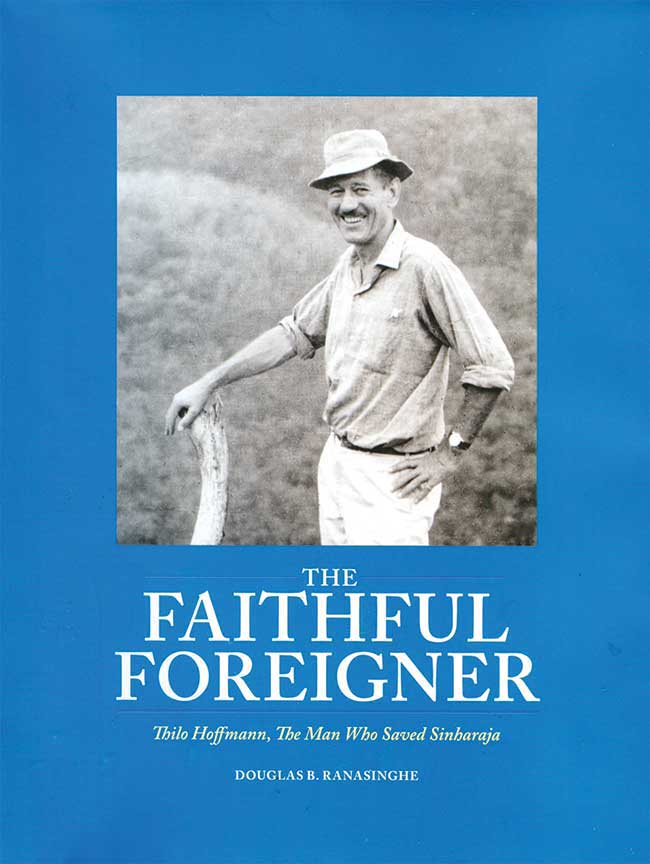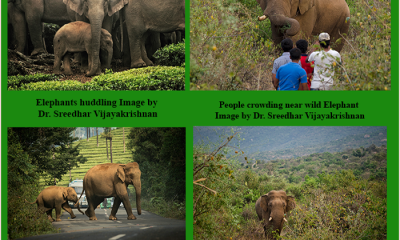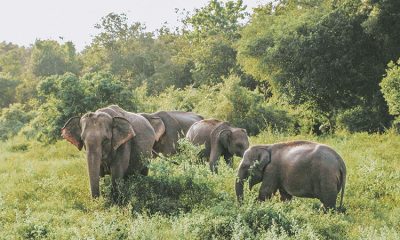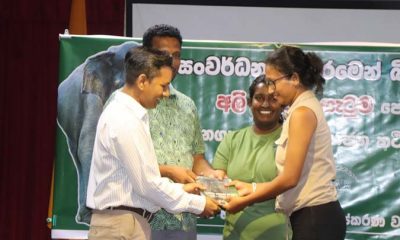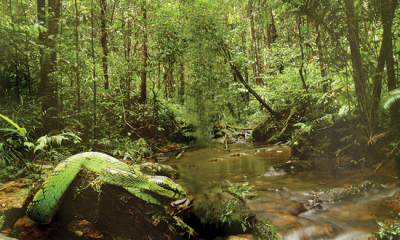Features
Thilo Hoffmann’s contribution towards improving and creating protected areas

Excerpted from the authorized biography of Thilo Hoffmann by Douglas. B. Ranasinghe
Set out below is an account of Thilo Hoffmann’s other work in nature conservation site by site. Further details about his involvement in some of these sites and yet others are found elsewhere in this book.
1) Wilpattu National Park
When the important Western section of Wilpattu had only the status of Sanctuary, and it was even proposed that there should be a public road across it, Thilo intervened on behalf of the WNPS and persuaded the government to make it part of the Wilpattu National Park.
The two Intermediate Zones to the South and East were incorporated in the Park at his suggestion. It was an important consolidation, as the Wilpattu East IZ occupied a major portion of the present Park.
He proposed, as also described in the last Chapter, a further extension to the Park as a Marine Sanctuary. This proposal, too, was supported by ample documentation prepared by him.In recognition of Hoffmann’s contribution to the cause of conservation of nature and wildlife in Sri Lanka, the Talawila bungalow at Wilpattu was named after him by the Ministry of State in 1985. On this occasion two conservationists were honoured in this manner, the other being Dr. RL Spittel.
2) The South-East Complex
On Hoffmann’s suggestion all the Intermediate Zones in the country were incorporated into National Parks. Thus the land in the Yala complex with that status was made part of the Yala, now Ruhunu, National Park. He also proposed extending the Park into the ocean to include the Basses ridge and reefs.
As the President of WNPS Thilo was pleased when the Society was invited on two occasions to participate in discussions at the Ministry of Irrigation, Power and Highways on the Heda Oya Project and the development of the Lower Uva area. He pointed out that, if implemented, the projects would have a very considerable impact on exiting and proposed conservation areas, notably the entire Yala complex, the Lahugala-Kitulana Sanctuary and also the very important Bundala Sanctuary, the two last named now National Park.
In 1977 Thilo gave his view on this project in an article to Loris under the title ‘Major Threat to the Oldest Wildlife Reserve’. He brought to the notice of technocrats and administrators that National Parks and other National Reserves are areas sacrosanct by definition and law, which cannot be altered and changed at will, that it is only the National State Assembly which can decree and approve boundary alterations in these.
Further, he strongly argued that buffer zones of natural forest or of plantation forest should be established and maintained in lieu of Intermediate Zones when the latter were incorporated in the National Parks. His opposition to the construction of hotels on the Yala coast is also set out together with his comments on visitor pressure at the Ruhunu National Parkrk’, below.
The Lahugala-Kitulana National Park of 1,550 hectares was declared on October 31, 1980 especially for the protection of elephants, and the Bundala National Park of 6,216 hectares was declared on October 15, 1990 mainly for waterbirds. The earlier planned development projects were abandoned.The Bundala National Park was named Sri Lanka’s first Ramsar Site in 1991. Thilo’s role in this, and the declaration of other Ramsar Sites, is also recorded in this book.
The Gal Oya National Park, of 25,900 hectares, was established on December 12, 1954 by the Gal Oya Development Board for the protection of the new reservoir, the Senanayake Samudraya, and was handed over to the Department of Wildlife in 1965. It lies in the dry zone low country, and is part of the Uva Province. The basic concept of the Park was to provide at least a small, fully protected catchment and protective area for the reservoir – whose total catchment is much larger.
Thilo made several visits, and reported to the authorities on shortcomings and the improvements that could be made. In April 1973 – just after climbing Ritigala Peak and despite a painful back injury, a slipped disc – Thilo spent four days in this National Park, sleeping in the open and walking long distances in the company of several officers of the Wildlife Department, in order to obtain a clear picture of the conditions in the Park at that time.
It contains the greatest extents of talawas with mana grass and the fire resistant aralu, bulu, nelli and gammalu (Pterocarpus marsupium) trees and madu. Hoffmann published a summary of the report on this visit in Loris, titled ‘The Gal-Oya National Park. His ideas, in brief, were:
1. This is the most beautiful and attractive National Park. The combination of its wildlife, notably elephants and birds, the special flora and the impressive landscape makes it ideal for visitors, including foreign tourists. The potential of the Park was great and basic access relatively easy with almost daily flights to and from Ampara. Opening it for visitors should be the first priority of the Department.
2. The boundaries of the Park should be altered with the inclusion of a few square miles of additional land, notably along the Western flank. The most important corrections suggested were those concerning the inclusion of the ‘Nilgala wedge’, the Pallang Oya Reservoir (now called Jayanthi Wewa), and all uninhabited land west of the Namal Oya and the reservoir of that name and/or the road from Iginiyagala to Mullegama.
3. For tourist and visitor development:
a) Have several boats because a trip on the waters of Senanayake Samudraya is an unforgettable experience and the best way to see elephants.
b) Establish one major viewing track and a few jeep tracks. The major track could be from Mullegama via Bubula and Henebedda to Makara where the Gal Oya River enters the lake through a picturesque boulder-strewn gorge.
c) A bungalow and a camping site at Makara.
These suggestions were made nearly 40 years ago and are still valid.
Some time later a foreign company proposed to take over the Gal Oya National Park and develop it as a tourist project. Thilo opposed this project because he feels that in a National Park only full government control, which is subject to public scrutiny, can guarantee the proper maintenance of correct conservation practices. Further, the Fauna and Flora Protection Ordinance does not allow the alienation of land under its purview, or commercial activities such as private tourist camps in National Parks.
This principled stand caused Thilo further worry in his dealings with the WWF, and added to his troubles in the matter of the presidency of the WNPS. The reasons were that a member of the WNPS Committee was the designated Manager of the private Gal Oya project, and the foreign company had close ties to the WWF.
Thilo and the WNPS had upheld the same position in the battle against a chain of hotels along the coast in the Yala National Park, and in the construction of the Society’s own bungalows, which are all outside National Parks.
4) Udawalawe National Park
After years of agitation by the WNPS, the Udawalawe National Park was declared by the Government in June 1972, when Mr S. D. Saparamadu was Director of the Department of Wildlife Conservation. Like Gal Oya it was mainly meant as a protection for the reservoir.
The new ‘Park’ was in desolate condition. It was crisscrossed by tracks for the extraction of timber and large-scale cultivation. Large numbers of people worked in felling camps, and many capitalist landholdings had been cleared. Bananas, chillies, tobacco, tomatoes and other crops were grown, with paid labour living in wadiyas on the land. Much of the forest had been cleared, and wild animals exterminated in these areas. The Park was a hive of illegal human activity.
There were also extensive teak plantations, and the State Timber Corporation was busy removing all the usable timber trees from the area.One month after the declaration Hoffmann visited the new Park, mostly on foot, during several days, and wrote a detailed report, which was later published in Loris, titled ‘The New Uda Walawe National Park’. A copy with a request for action was handed over to Mr Saparamadu as Director of the Wildlife Department. It is the only detailed account and description of the state of all parts of the Park at that time, and contains a number of specific recommendations for improvement.
During that visit the newly appointed Park Warden had stated: “It was a mistake to declare this Park.” He felt that it was beyond redemption, as did his mentor and friend, the earlier Director. Thilo comments:
“Contrary to what S. D. Saparamadu writes in his book Sri Lanka: A Wildlife Interlude (2006), the Wildlife and Nature Protection Society welcomed the establishment of the new Park for which it had lobbied over the years. This is recorded in the WNPS annual reports and Loris as they had foreseen its great potential.
The Society, however, was not happy when after the declaration nothing happened with regard to the desperate situation of the Park, despite the appointment of a few staff without the means to assert the Department’s authority over it. When Director Saparamadu retired a few years later, in early 1975, the Park was in the same desolate state.
Subsequent Directors did what was required, and the Park was properly opened for the public in 1980. It was also somewhat enlarged, and now comprises 30,821 hectares. It has amply fulfilled the high expectations which Thilo and the WNPS had of it. Thilo says:
“Saparamadu’s book contains many more distortions, manipulations of facts and downright untruths. There is hardly a chapter in which he does not disparagingly refer to “the wildlife establishment”, by which he means the WNPS, described as “western educated, English speaking and mostly Christian”. He and – in some ways – his predecessor were the extreme cases of supercilious bureaucrats with minds battened down against anything and anyone outside their own establishment. Arrogant confrontation and denial instead of friendly collaboration was the rule.”
In Thilo’s report to Loris in 1972 – written after his visit – he noted the matters set out below:
1. In the eastern sector, there were at least four timber wadiyas. The area had been systematically logged since the 1950s. As a result there were no large trees to be seen anywhere.
2. Large tracts of abandoned chenas were overgrown with Lantana and eupatorium, the latter recently introduced from abroad: New land was being cleared for cultivation.
3. The Forest Department had established 3,500 acres of teak plantations in the Park. 500 acres were newly earmarked for a three-year chena control system.
4. Inside the eastern sector there are two ancient villages, Sinuggala with four families and Nebodawewa with two families.
5. Few animals were observed. A leopard was seen, a very rare occurrence here. The presence of elephants was noted. It was recorded that there was a potential carrying capacity of about 150 elephants. Though not a single spotted deer was seen, dry deer skins were observed in timber wadiyas.
6. Logs were being loaded into lorries using tame elephants.
7. The situation in the western sector of the Park (west of the Walawe River) was very similar with chenas and settlements. The latter would have to be excised, but the higher lying part, north of Kuda Oya, was ecologically very valuable because of its special character, containing talawa.
The report (in 1972) ended with the following sentence: “The new Uda Walawe National Park has a future and is worth a special effort; no more time must, however, be wasted.”
Features
The heart-friendly health minister

by Dr Gotabhya Ranasinghe
Senior Consultant Cardiologist
National Hospital Sri Lanka
When we sought a meeting with Hon Dr. Ramesh Pathirana, Minister of Health, he graciously cleared his busy schedule to accommodate us. Renowned for his attentive listening and deep understanding, Minister Pathirana is dedicated to advancing the health sector. His openness and transparency exemplify the qualities of an exemplary politician and minister.
Dr. Palitha Mahipala, the current Health Secretary, demonstrates both commendable enthusiasm and unwavering support. This combination of attributes makes him a highly compatible colleague for the esteemed Minister of Health.
Our discussion centered on a project that has been in the works for the past 30 years, one that no other minister had managed to advance.
Minister Pathirana, however, recognized the project’s significance and its potential to revolutionize care for heart patients.
The project involves the construction of a state-of-the-art facility at the premises of the National Hospital Colombo. The project’s location within the premises of the National Hospital underscores its importance and relevance to the healthcare infrastructure of the nation.
This facility will include a cardiology building and a tertiary care center, equipped with the latest technology to handle and treat all types of heart-related conditions and surgeries.
Securing funding was a major milestone for this initiative. Minister Pathirana successfully obtained approval for a $40 billion loan from the Asian Development Bank. With the funding in place, the foundation stone is scheduled to be laid in September this year, and construction will begin in January 2025.
This project guarantees a consistent and uninterrupted supply of stents and related medications for heart patients. As a result, patients will have timely access to essential medical supplies during their treatment and recovery. By securing these critical resources, the project aims to enhance patient outcomes, minimize treatment delays, and maintain the highest standards of cardiac care.
Upon its fruition, this monumental building will serve as a beacon of hope and healing, symbolizing the unwavering dedication to improving patient outcomes and fostering a healthier society.We anticipate a future marked by significant progress and positive outcomes in Sri Lanka’s cardiovascular treatment landscape within the foreseeable timeframe.
Features
A LOVING TRIBUTE TO JESUIT FR. ALOYSIUS PIERIS ON HIS 90th BIRTHDAY

by Fr. Emmanuel Fernando, OMI
Jesuit Fr. Aloysius Pieris (affectionately called Fr. Aloy) celebrated his 90th birthday on April 9, 2024 and I, as the editor of our Oblate Journal, THE MISSIONARY OBLATE had gone to press by that time. Immediately I decided to publish an article, appreciating the untiring selfless services he continues to offer for inter-Faith dialogue, the renewal of the Catholic Church, his concern for the poor and the suffering Sri Lankan masses and to me, the present writer.
It was in 1988, when I was appointed Director of the Oblate Scholastics at Ampitiya by the then Oblate Provincial Fr. Anselm Silva, that I came to know Fr. Aloy more closely. Knowing well his expertise in matters spiritual, theological, Indological and pastoral, and with the collaborative spirit of my companion-formators, our Oblate Scholastics were sent to Tulana, the Research and Encounter Centre, Kelaniya, of which he is the Founder-Director, for ‘exposure-programmes’ on matters spiritual, biblical, theological and pastoral. Some of these dimensions according to my view and that of my companion-formators, were not available at the National Seminary, Ampitiya.
Ever since that time, our Oblate formators/ accompaniers at the Oblate Scholasticate, Ampitiya , have continued to send our Oblate Scholastics to Tulana Centre for deepening their insights and convictions regarding matters needed to serve the people in today’s context. Fr. Aloy also had tried very enthusiastically with the Oblate team headed by Frs. Oswald Firth and Clement Waidyasekara to begin a Theologate, directed by the Religious Congregations in Sri Lanka, for the contextual formation/ accompaniment of their members. It should very well be a desired goal of the Leaders / Provincials of the Religious Congregations.
Besides being a formator/accompanier at the Oblate Scholasticate, I was entrusted also with the task of editing and publishing our Oblate journal, ‘The Missionary Oblate’. To maintain the quality of the journal I continue to depend on Fr. Aloy for his thought-provoking and stimulating articles on Biblical Spirituality, Biblical Theology and Ecclesiology. I am very grateful to him for his generous assistance. Of late, his writings on renewal of the Church, initiated by Pope St. John XX111 and continued by Pope Francis through the Synodal path, published in our Oblate journal, enable our readers to focus their attention also on the needed renewal in the Catholic Church in Sri Lanka. Fr. Aloy appreciated very much the Synodal path adopted by the Jesuit Pope Francis for the renewal of the Church, rooted very much on prayerful discernment. In my Religious and presbyteral life, Fr.Aloy continues to be my spiritual animator / guide and ongoing formator / acccompanier.
Fr. Aloysius Pieris, BA Hons (Lond), LPh (SHC, India), STL (PFT, Naples), PhD (SLU/VC), ThD (Tilburg), D.Ltt (KU), has been one of the eminent Asian theologians well recognized internationally and one who has lectured and held visiting chairs in many universities both in the West and in the East. Many members of Religious Congregations from Asian countries have benefited from his lectures and guidance in the East Asian Pastoral Institute (EAPI) in Manila, Philippines. He had been a Theologian consulted by the Federation of Asian Bishops’ Conferences for many years. During his professorship at the Gregorian University in Rome, he was called to be a member of a special group of advisers on other religions consulted by Pope Paul VI.
Fr. Aloy is the author of more than 30 books and well over 500 Research Papers. Some of his books and articles have been translated and published in several countries. Among those books, one can find the following: 1) The Genesis of an Asian Theology of Liberation (An Autobiographical Excursus on the Art of Theologising in Asia, 2) An Asian Theology of Liberation, 3) Providential Timeliness of Vatican 11 (a long-overdue halt to a scandalous millennium, 4) Give Vatican 11 a chance, 5) Leadership in the Church, 6) Relishing our faith in working for justice (Themes for study and discussion), 7) A Message meant mainly, not exclusively for Jesuits (Background information necessary for helping Francis renew the Church), 8) Lent in Lanka (Reflections and Resolutions, 9) Love meets wisdom (A Christian Experience of Buddhism, 10) Fire and Water 11) God’s Reign for God’s poor, 12) Our Unhiddden Agenda (How we Jesuits work, pray and form our men). He is also the Editor of two journals, Vagdevi, Journal of Religious Reflection and Dialogue, New Series.
Fr. Aloy has a BA in Pali and Sanskrit from the University of London and a Ph.D in Buddhist Philosophy from the University of Sri Lankan, Vidyodaya Campus. On Nov. 23, 2019, he was awarded the prestigious honorary Doctorate of Literature (D.Litt) by the Chancellor of the University of Kelaniya, the Most Venerable Welamitiyawe Dharmakirthi Sri Kusala Dhamma Thera.
Fr. Aloy continues to be a promoter of Gospel values and virtues. Justice as a constitutive dimension of love and social concern for the downtrodden masses are very much noted in his life and work. He had very much appreciated the commitment of the late Fr. Joseph (Joe) Fernando, the National Director of the Social and Economic Centre (SEDEC) for the poor.
In Sri Lanka, a few religious Congregations – the Good Shepherd Sisters, the Christian Brothers, the Marist Brothers and the Oblates – have invited him to animate their members especially during their Provincial Congresses, Chapters and International Conferences. The mainline Christian Churches also have sought his advice and followed his seminars. I, for one, regret very much, that the Sri Lankan authorities of the Catholic Church –today’s Hierarchy—- have not sought Fr.
Aloy’s expertise for the renewal of the Catholic Church in Sri Lanka and thus have not benefited from the immense store of wisdom and insight that he can offer to our local Church while the Sri Lankan bishops who governed the Catholic church in the immediate aftermath of the Second Vatican Council (Edmund Fernando OMI, Anthony de Saram, Leo Nanayakkara OSB, Frank Marcus Fernando, Paul Perera,) visited him and consulted him on many matters. Among the Tamil Bishops, Bishop Rayappu Joseph was keeping close contact with him and Bishop J. Deogupillai hosted him and his team visiting him after the horrible Black July massacre of Tamils.
Features
A fairy tale, success or debacle

Sri Lanka-Singapore Free Trade Agreement
By Gomi Senadhira
senadhiragomi@gmail.com
“You might tell fairy tales, but the progress of a country cannot be achieved through such narratives. A country cannot be developed by making false promises. The country moved backward because of the electoral promises made by political parties throughout time. We have witnessed that the ultimate result of this is the country becoming bankrupt. Unfortunately, many segments of the population have not come to realize this yet.” – President Ranil Wickremesinghe, 2024 Budget speech
Any Sri Lankan would agree with the above words of President Wickremesinghe on the false promises our politicians and officials make and the fairy tales they narrate which bankrupted this country. So, to understand this, let’s look at one such fairy tale with lots of false promises; Ranil Wickremesinghe’s greatest achievement in the area of international trade and investment promotion during the Yahapalana period, Sri Lanka-Singapore Free Trade Agreement (SLSFTA).
It is appropriate and timely to do it now as Finance Minister Wickremesinghe has just presented to parliament a bill on the National Policy on Economic Transformation which includes the establishment of an Office for International Trade and the Sri Lanka Institute of Economics and International Trade.
Was SLSFTA a “Cleverly negotiated Free Trade Agreement” as stated by the (former) Minister of Development Strategies and International Trade Malik Samarawickrama during the Parliamentary Debate on the SLSFTA in July 2018, or a colossal blunder covered up with lies, false promises, and fairy tales? After SLSFTA was signed there were a number of fairy tales published on this agreement by the Ministry of Development Strategies and International, Institute of Policy Studies, and others.
However, for this article, I would like to limit my comments to the speech by Minister Samarawickrama during the Parliamentary Debate, and the two most important areas in the agreement which were covered up with lies, fairy tales, and false promises, namely: revenue loss for Sri Lanka and Investment from Singapore. On the other important area, “Waste products dumping” I do not want to comment here as I have written extensively on the issue.
1. The revenue loss
During the Parliamentary Debate in July 2018, Minister Samarawickrama stated “…. let me reiterate that this FTA with Singapore has been very cleverly negotiated by us…. The liberalisation programme under this FTA has been carefully designed to have the least impact on domestic industry and revenue collection. We have included all revenue sensitive items in the negative list of items which will not be subject to removal of tariff. Therefore, 97.8% revenue from Customs duty is protected. Our tariff liberalisation will take place over a period of 12-15 years! In fact, the revenue earned through tariffs on goods imported from Singapore last year was Rs. 35 billion.
The revenue loss for over the next 15 years due to the FTA is only Rs. 733 million– which when annualised, on average, is just Rs. 51 million. That is just 0.14% per year! So anyone who claims the Singapore FTA causes revenue loss to the Government cannot do basic arithmetic! Mr. Speaker, in conclusion, I call on my fellow members of this House – don’t mislead the public with baseless criticism that is not grounded in facts. Don’t look at petty politics and use these issues for your own political survival.”
I was surprised to read the minister’s speech because an article published in January 2018 in “The Straits Times“, based on information released by the Singaporean Negotiators stated, “…. With the FTA, tariff savings for Singapore exports are estimated to hit $10 million annually“.
As the annual tariff savings (that is the revenue loss for Sri Lanka) calculated by the Singaporean Negotiators, Singaporean $ 10 million (Sri Lankan rupees 1,200 million in 2018) was way above the rupees’ 733 million revenue loss for 15 years estimated by the Sri Lankan negotiators, it was clear to any observer that one of the parties to the agreement had not done the basic arithmetic!
Six years later, according to a report published by “The Morning” newspaper, speaking at the Committee on Public Finance (COPF) on 7th May 2024, Mr Samarawickrama’s chief trade negotiator K.J. Weerasinghehad had admitted “…. that forecasted revenue loss for the Government of Sri Lanka through the Singapore FTA is Rs. 450 million in 2023 and Rs. 1.3 billion in 2024.”
If these numbers are correct, as tariff liberalisation under the SLSFTA has just started, we will pass Rs 2 billion very soon. Then, the question is how Sri Lanka’s trade negotiators made such a colossal blunder. Didn’t they do their basic arithmetic? If they didn’t know how to do basic arithmetic they should have at least done their basic readings. For example, the headline of the article published in The Straits Times in January 2018 was “Singapore, Sri Lanka sign FTA, annual savings of $10m expected”.
Anyway, as Sri Lanka’s chief negotiator reiterated at the COPF meeting that “…. since 99% of the tariffs in Singapore have zero rates of duty, Sri Lanka has agreed on 80% tariff liberalisation over a period of 15 years while expecting Singapore investments to address the imbalance in trade,” let’s turn towards investment.
Investment from Singapore
In July 2018, speaking during the Parliamentary Debate on the FTA this is what Minister Malik Samarawickrama stated on investment from Singapore, “Already, thanks to this FTA, in just the past two-and-a-half months since the agreement came into effect we have received a proposal from Singapore for investment amounting to $ 14.8 billion in an oil refinery for export of petroleum products. In addition, we have proposals for a steel manufacturing plant for exports ($ 1 billion investment), flour milling plant ($ 50 million), sugar refinery ($ 200 million). This adds up to more than $ 16.05 billion in the pipeline on these projects alone.
And all of these projects will create thousands of more jobs for our people. In principle approval has already been granted by the BOI and the investors are awaiting the release of land the environmental approvals to commence the project.
I request the Opposition and those with vested interests to change their narrow-minded thinking and join us to develop our country. We must always look at what is best for the whole community, not just the few who may oppose. We owe it to our people to courageously take decisions that will change their lives for the better.”
According to the media report I quoted earlier, speaking at the Committee on Public Finance (COPF) Chief Negotiator Weerasinghe has admitted that Sri Lanka was not happy with overall Singapore investments that have come in the past few years in return for the trade liberalisation under the Singapore-Sri Lanka Free Trade Agreement. He has added that between 2021 and 2023 the total investment from Singapore had been around $162 million!
What happened to those projects worth $16 billion negotiated, thanks to the SLSFTA, in just the two-and-a-half months after the agreement came into effect and approved by the BOI? I do not know about the steel manufacturing plant for exports ($ 1 billion investment), flour milling plant ($ 50 million) and sugar refinery ($ 200 million).
However, story of the multibillion-dollar investment in the Petroleum Refinery unfolded in a manner that would qualify it as the best fairy tale with false promises presented by our politicians and the officials, prior to 2019 elections.
Though many Sri Lankans got to know, through the media which repeatedly highlighted a plethora of issues surrounding the project and the questionable credentials of the Singaporean investor, the construction work on the Mirrijiwela Oil Refinery along with the cement factory began on the24th of March 2019 with a bang and Minister Ranil Wickremesinghe and his ministers along with the foreign and local dignitaries laid the foundation stones.
That was few months before the 2019 Presidential elections. Inaugurating the construction work Prime Minister Ranil Wickremesinghe said the projects will create thousands of job opportunities in the area and surrounding districts.
The oil refinery, which was to be built over 200 acres of land, with the capacity to refine 200,000 barrels of crude oil per day, was to generate US$7 billion of exports and create 1,500 direct and 3,000 indirect jobs. The construction of the refinery was to be completed in 44 months. Four years later, in August 2023 the Cabinet of Ministers approved the proposal presented by President Ranil Wickremesinghe to cancel the agreement with the investors of the refinery as the project has not been implemented! Can they explain to the country how much money was wasted to produce that fairy tale?
It is obvious that the President, ministers, and officials had made huge blunders and had deliberately misled the public and the parliament on the revenue loss and potential investment from SLSFTA with fairy tales and false promises.
As the president himself said, a country cannot be developed by making false promises or with fairy tales and these false promises and fairy tales had bankrupted the country. “Unfortunately, many segments of the population have not come to realize this yet”.
(The writer, a specialist and an activist on trade and development issues . )

